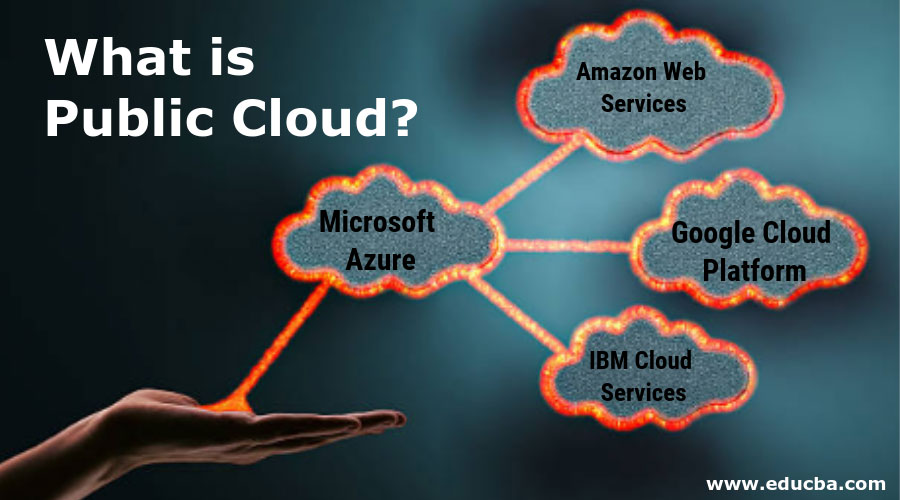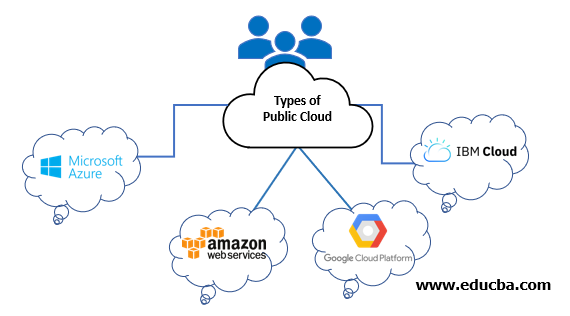Updated March 23, 2023

Introduction of Public Cloud
The cloud services are offered through the public internet and provided by third-party providers is called public cloud. It is made available to anyone over the internet. However, companies do not share sensitive information through public cloud dues to the safety issues. The cloud services are provided free always, or they will be provided as pay per use to the customer. The public cloud has many virtual resources, and it is automatically managed by different clients. If there are demand fluctuations, it is easily managed through these resources. It can be used for single application development
Different Types of Public Cloud
Public Cloud has a unique feature as broad network access in which wide resources like storage and virtual machines can be accessed easily with the mobile phone, personal laptops, and computers. Hence it can be accessed at any time. The Resource Pooling allows multiple users to share a common pool like database, applications and web pages and provides rapid elasticity to resources used by clients or recently assigned to clients is automatically monitored. It is very possible to scale the resource up and down at any time.
1. Microsoft Azure
It is one of the topmost cloud platforms and products of Microsoft, which is made to deliver scalable service, application services, messaging facilities, data storage services, and efficient databases. The aim of the Azure cloud is to give persistent service by efficient data storage and helps the company to give an instant and accurate solution with available data in the database in every component of the industry. Security is the most important thing that should be given to every customer.
It is not like only the large scale industry has to protect the data. The data and service should also be protected for small scale industry even for our mobile. The security is equally provided to all the users from business to customers and business to business. With the help of a single sign-on feature, it is easily accessible to all of the users.
It tracks the data of the user and their status of access and cross-checks with the database that contains all the user, admin, and employees, customers details. So if there are a hole and any hacker can enter, it generates an alarm and sends the alert to prevent data snap or data loss. It is more location-specific and has control in all its integrated devices.
2. Amazon Web Services
It enables the users with hosting and management of services in the cyberspace. Some of the esteemed organizations use AWS to build, host, manage and organize the infrastructure of the company. Here cloud platform offers many benefits to users cloud-based data storage, transfer of application and management storage.
3. Google Cloud Platform
It is a popular cloud platform that provides a document aided database, cloud computing, and elastic database. It is the third-largest cloud platform that powers Machine Intellect, Google analytics, etc. The software helps to train the system of users. The elements include the Google cloud platform console, cloud, and REST API. Google Cloud helps in analyzing, training and modifying a user’s system.
The developed and designed system gets deployed in user infrastructure. Users will receive predictions, and monitoring of predictions will be able to manage user design and its related versions. Google Cloud ML has three components include Google Cloud Platform console, Gcloud, and Rest API to design, analyze and deploy on the user interface. It provides stability and firm support.
4. IBM Cloud Services
It operates like a Q and A session that offers services to SUSE Linux Servers in the framework of Apache Hadoop. If a user designs his system with Watson, there is a possibility of high understanding and efficient output from that device. It gathers knowledge from small information, and for application development, it uses API. It is a robust system which makes smarter business.
Structure of Public Cloud
The basic structure is given below:
1. Infrastructure as a service (IaaS)
Cloud computing providers virtual and physical computers. The virtual machines are accessed by hypervisors that are grouped into pools and controlled by operational supportive networks. Cloud computing introduces working framework pictures on virtual machines and application programming. IaaS offers resources like IP addresses, firewalls, monitoring services, storage, bandwidth, virtual machines and so on; all are made accessible to the clients on a cost on a time basis.
Examples: Windows Azure, Google Compute Engine, Amazon EC2, Rackspace
2. Platform as a service (PaaS)
It is the part of the delivery of the application development and deployment platform as a service to developers, who can utilize the platform to build, deploy and manage SaaS applications effectively. The major element of PaaS has point-and-snap equipment that empowers the programmer to make web-based applications.
Examples: Force.com, Google, Apache StratosApp, Engine, Windows Azure, AWS Elastic Beanstalk.
3. Software as a Service (SaaS)
It is the transmission of Applications to end-users over the web through browsers. Cloud clients install it, and they can enable them to run on the cloud infrastructure. But it is not mandatory for this process because the need for software maintenance and support is reduced. Instead, they can use SaaS applications which is portable. For example, an Office Suite. SaaS provides us with the Application Programming Interface (API), which allows the developers to build a customized application.
Example: Google Apps, Microsoft Office 365
Examples of Cloud
The related examples have been explained below:
- Several examples of public cloud which are used extensively are cloud storage services, online software applications, cloud-based development and deployment environments, web hosting and cloud hosting. The User who requires a minimum level of infrastructure and security prefers the public cloud extensively. Business people use the cloud effectively for their operations, such as non-confidential data and collaboration on online documents.
- This is in demand by many organizations for their fast and secure delivery, rapid processing, reliable transmission of data without any loss, pocket-friendly set-up. Benefited companies who prefer public cloud include web service providers, e-commerce, cloud service providers, network operators, cloud service providers. It allows users to develop their networks according to the requirements in cloud-based services.
- An authentic cloud network offers high-end monitoring to the globally located servers, controls the traffic flow between interconnected servers, protects the systems with advanced network security and gives visibility to the user by its centralized management.
Recommended Articles
This is a guide to What is Public Cloud? Here we discuss different types of Public clouds with the structure of the cloud and several examples. You can also go through our other suggested articles to learn more-


